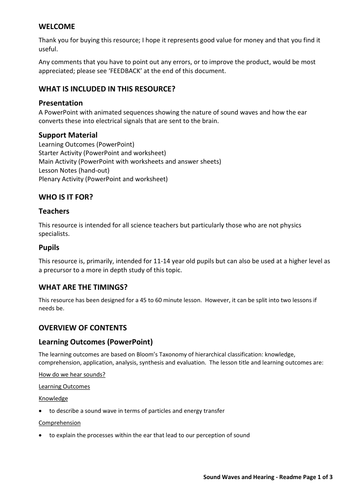












The main presentation is a PowerPoint with animated sequences showing the nature of sound waves and how the ear converts these into electrical signals that are sent to the brain.
Support Material
Readme (instructions for whole lesson)
Learning Outcomes (PowerPoint)
Starter Activity (PowerPoint and Worksheet)
Main Activity (PowerPoint with worksheets and answer sheets)
Lesson Notes (hand-out)
Plenary Activity (PowerPoint and worksheet)
It is intended for all science teachers but particularly those who are not physics specialists. It is, primarily, aimed at 11 to 14 year old pupils but can also be used at a higher level for the purposes of revision. Normally, the activities would fill a 45 to 60 minute lesson .
If you buy this resource, please print the Readme document as it contains the instructions and details of the files included.
Learning Outcomes
The learning outcomes are based on Bloom’s taxonomy of hierarchical classification: knowledge, comprehension, application, analysis, synthesis and evaluation. The lesson title and learning outcomes are:
How do we hear sounds?
Learning Outcomes
Knowledge
- to describe a sound wave in terms of particles and energy transfer
Comprehension - to explain the processes within the ear that lead to our perception of sound
Differentiation
The activities have varying degrees of differentiation; please refer to the Readme document.
Something went wrong, please try again later.
Report this resourceto let us know if it violates our terms and conditions.
Our customer service team will review your report and will be in touch.